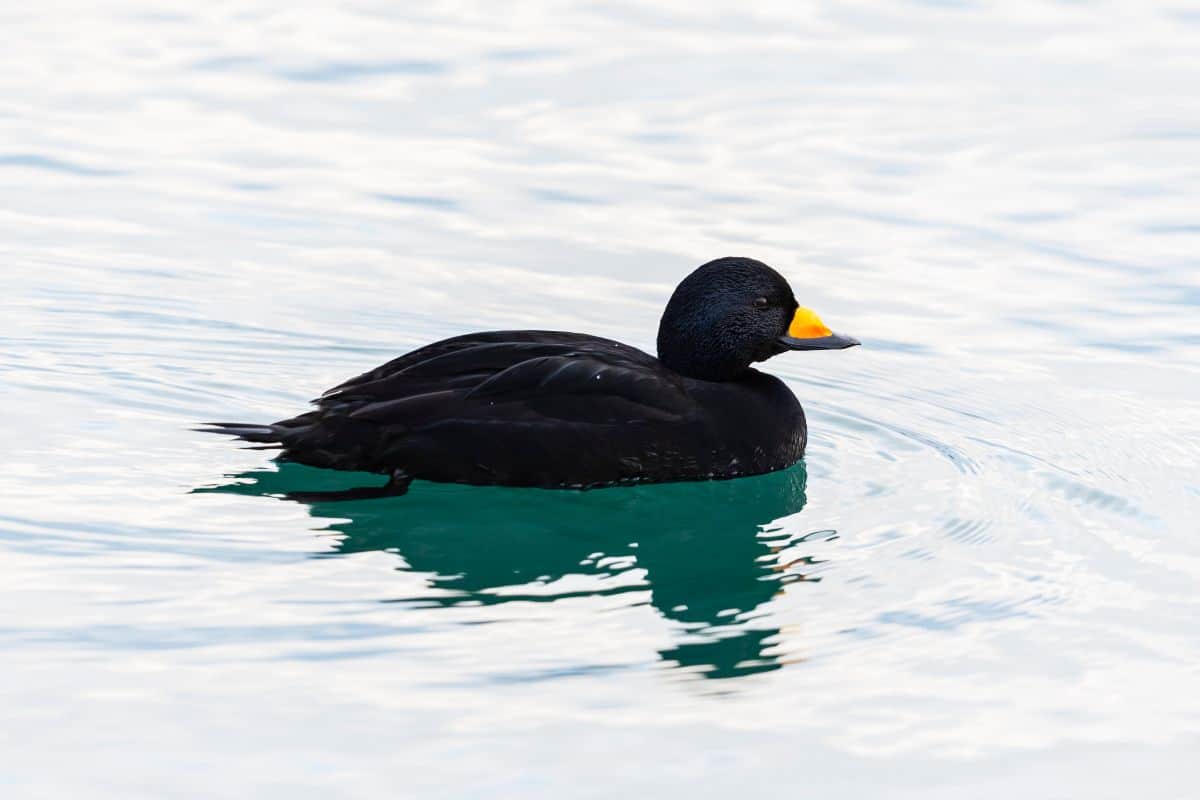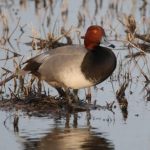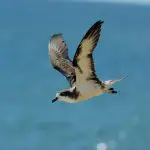Common Name: Black Scoter
Scientific Name: Melanitta americana| Size | Diet | Range in Hawaii | Status in Hawaii |
|---|---|---|---|
| 16 in. - 19 in. | clams, mussels, and crustaceans | Northwestern Hawaiian Islands (Midway Atoll) | Near Threatened |
The Black Scoter (Melanitta americana) is a sea duck that is found primarily along the coasts of North America. With its striking black plumage and bright orange bill, the Black Scoter is a fascinating and charismatic bird that has captured the attention of birdwatchers and nature enthusiasts around the world. While the Black Scoter is not a native species to Hawaii, it has been known to occasionally appear in the islands during the winter months.
In this article, we’ll take a closer look at the Black Scoter, including its appearance, behavior, and habitat, as well as its occasional presence in Hawaii and the impact of human activities on its survival.
Black Scoter
Appearance
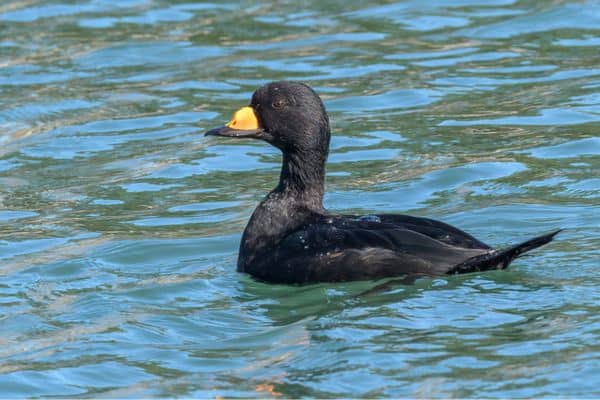
The Black Scoter is a medium-sized sea duck that measures approximately 16-19 inches in length and weighs between 1.5-2.5 pounds. The male of the species has striking black plumage with a bright orange bill, while the female has a dark brown head and neck with a light brown body.
Both sexes have rounded heads and relatively short necks, giving them a distinctive profile on the water. The Black Scoter’s bill is highly specialized for feeding on marine invertebrates, with a serrated edge that allows it to grip and crush its prey.
Diet
The Black Scoter is a sea duck that feeds primarily on marine invertebrates such as clams, mussels, and crustaceans. The Black Scoter’s highly specialized bill is perfectly adapted for crushing the shells of these prey items, allowing it to access the nutritious meat inside.
In addition to invertebrates, the Black Scoter may also feed on small fish such as herring and sand lance, as well as aquatic plants and algae. The Black Scoter typically feeds by diving to great depths in search of food, using its powerful wings and body to propel itself underwater.
Nesting
The Black Scoter typically nests in the boreal forests of North America, near freshwater lakes and rivers. The female constructs a nest on the ground, usually concealed among vegetation or other natural cover.
The nest is typically made of twigs, grasses, and other plant materials, and is lined with downy feathers from the female’s breast. The female will lay a clutch of 5-10 eggs, which she incubates for approximately 28-30 days.
Both the male and female take an active role in caring for the young ducklings once they hatch, providing them with food and protection from predators.
Behavior
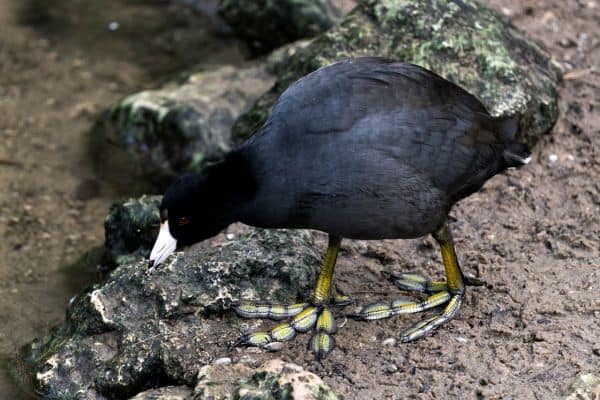
The Black Scoter is a social and highly gregarious bird that is often found in large flocks during the non-breeding season. These flocks may number in the hundreds or even thousands of individuals, and are typically found in coastal habitats such as bays, estuaries, and open ocean.
The Black Scoter is a skilled and powerful swimmer, able to dive to great depths in search of food and evade predators. During the breeding season, males will engage in elaborate courtship displays, including head-bobbing, wing-flapping, and vocalizations.
The Black Scoter’s vocalizations are a key part of its behavior, with the birds communicating with each other using a variety of whistles, grunts, and quacks.
Habitat
The Black Scoter’s habitat includes a wide range of coastal environments, including bays, estuaries, open ocean, and rocky shorelines. The Black Scoter is typically found in areas with abundant food resources, such as areas with high densities of clams, mussels, and other marine invertebrates.
During the breeding season, the Black Scoter nests in the boreal forests of North America, near freshwater lakes and rivers. The Black Scoter’s habitat is an important part of its overall ecology, as it provides the resources and conditions necessary for the bird to survive and thrive across its range.
Range
The Black Scoter is not native to Hawaii, but it has been accidentally spotted in the Northwestern Hawaiian Islands, specifically at Midway Atoll. This sighting suggests that the Black Scoter may occasionally occur in Hawaii’s waters during its migration.
Conservation Status
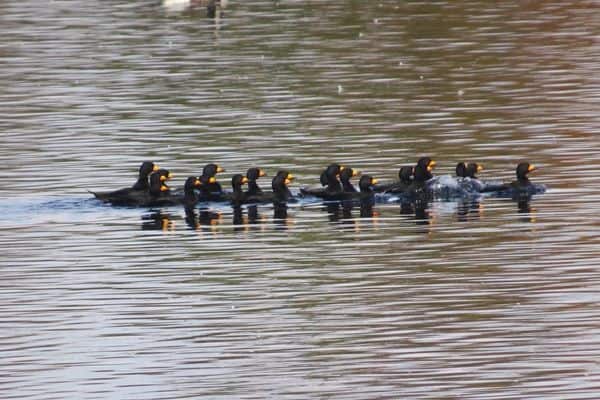
The Black Scoter is currently listed as “Near Threatened” on the IUCN Red List. This means that the species is at risk of becoming threatened with extinction in the near future if conservation measures are not taken.
The Black Scoter’s population is declining due to a variety of threats, including habitat loss and degradation, pollution, and climate change. The species is also vulnerable to oil spills and hunting.
Interesting Facts
1. Social and highly gregarious bird
The Black Scoter is a social and highly gregarious bird that is often found in large flocks during the non-breeding season.
2. A skilled and powerful swimmer
The Black Scoter is a skilled and powerful swimmer, able to dive to great depths in search of food and evade predators.
3. Renowned for its robust and straight flight
The Black Scoter is known for its strong, direct flight, which can reach speeds of up to 60 miles per hour.
Frequently Asked Questions
1. What is the Black Scoter’s lifespan?
The Black Scoter has a relatively long lifespan for a bird, with some individuals living up to 15 years in the wild.
2. What is the Black Scoter’s vocalization like?
The Black Scoter is known for its distinctive vocalizations, which include a variety of whistles, grunts, and quacks.
3. How does the Black Scoter communicate with other birds?
The Black Scoter communicates with other birds through a variety of vocalizations, body language, and displays, particularly during the breeding season.
